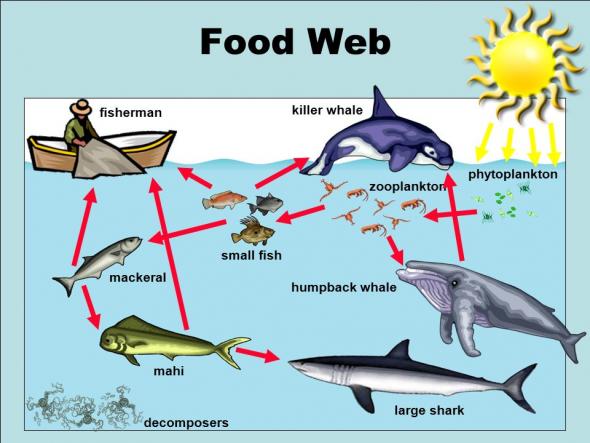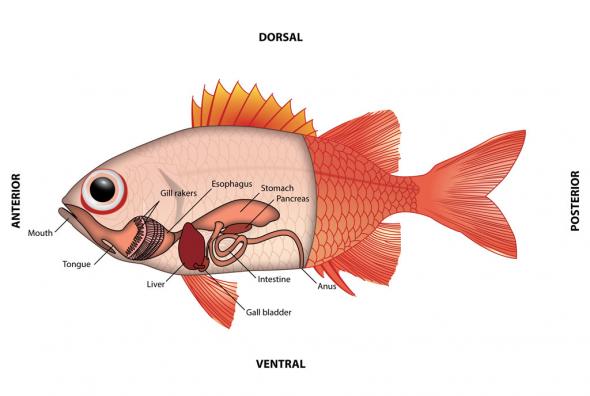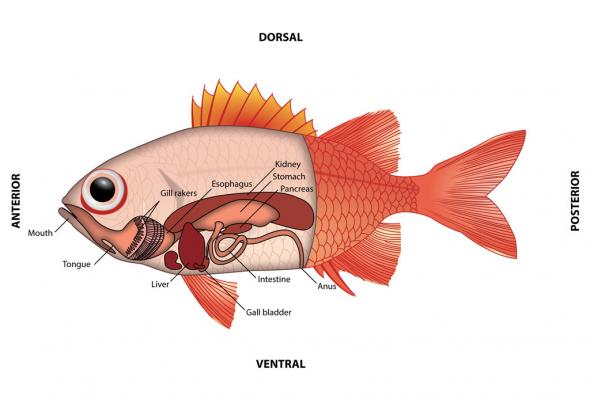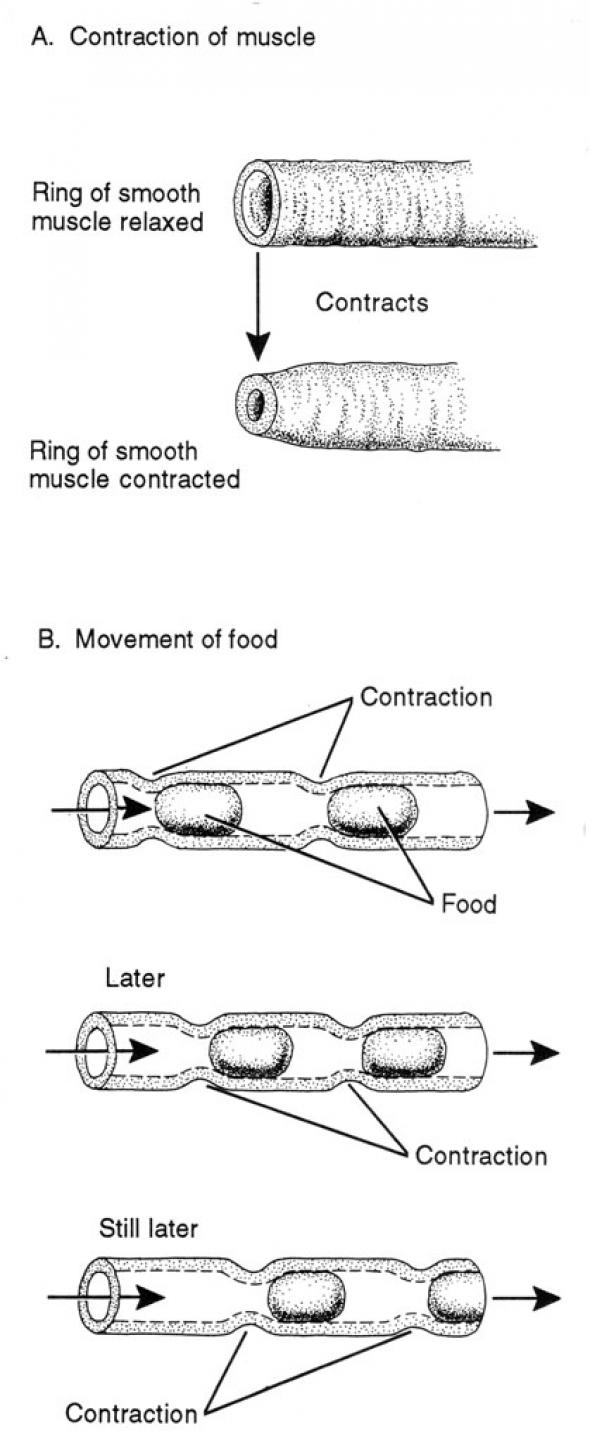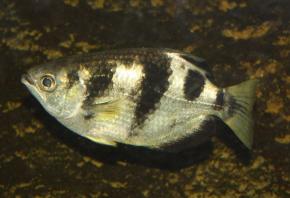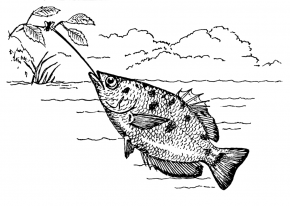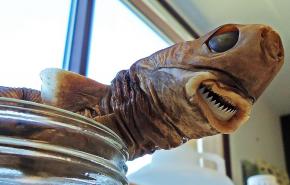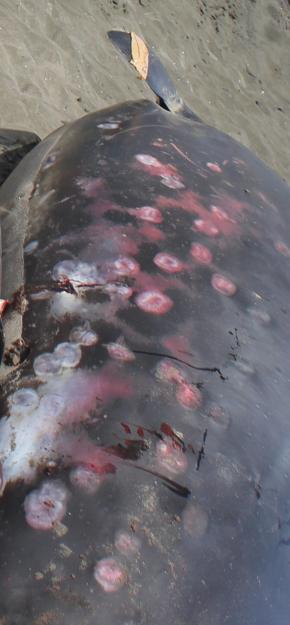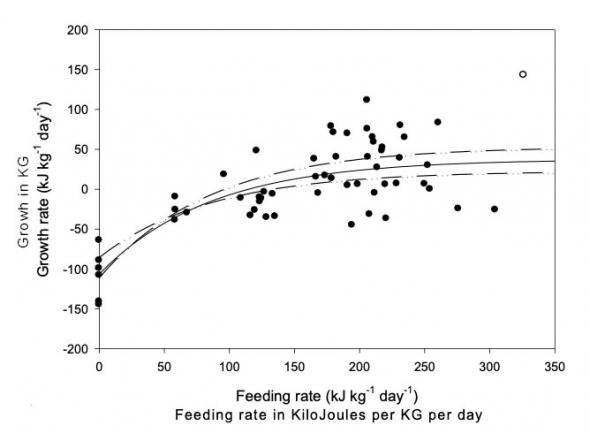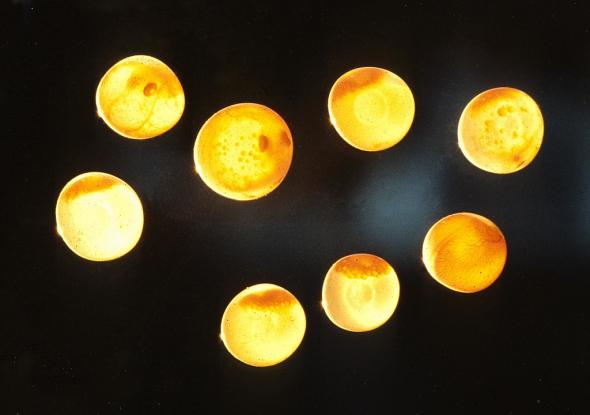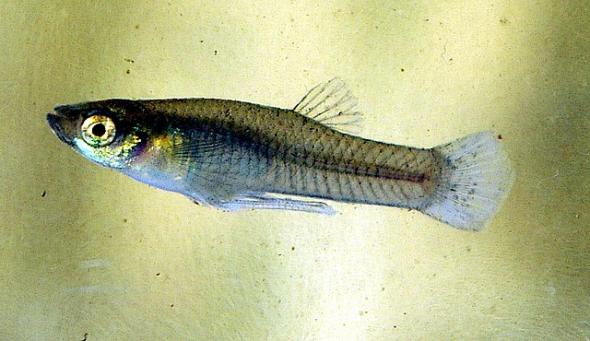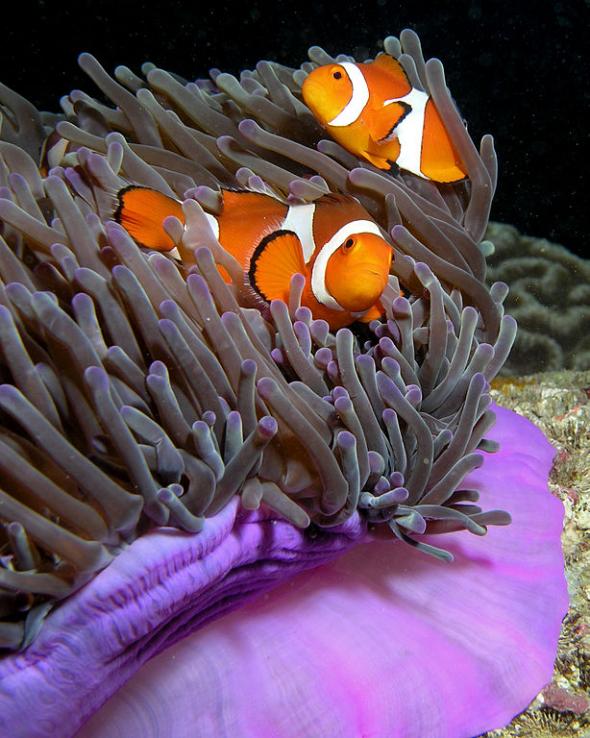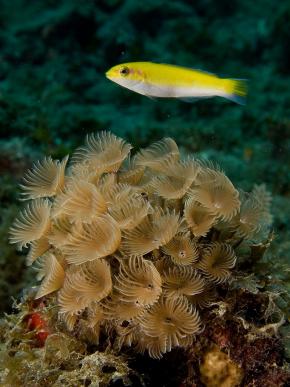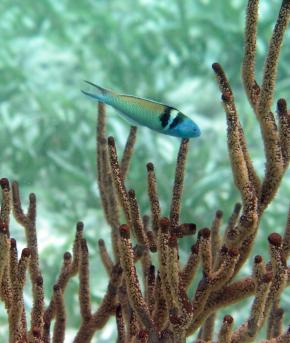Fish Diets
Fish eat a wide variety of food items. The world’s largest fish—the whale shark—eats microscopic food items called plankton. The term plankton describes any aquatic organism that cannot swim against a current. Examples of plankton in a whale shark’s diet include tiny crustaceans, fish eggs, and jellyfish.
Some fish eat algae and aquatic plants. For example, the grazing of surgeonfish prevents seaweeds from smothering tropical coral reefs. Other fish species are active predators, hunting other organisms. Examples of predatory fish include sharks, tunas, swordfish, snappers, eels, and groupers.
Collectively, fish are part of the ocean food web. Producers, like algae and phytoplankton, provide food for the various types of animals in the ocean, including fish (Fig. 4.62).
Image caption
Fig. 4.62. An ocean food web incorporates many different organisms in an ecosystem, from primary producers to consumers like fish, fishermen, and whales, as well as decomposers like brittle stars and bacteria.
Image copyright and source
Digestive System
The digestive system of fish breaks food into smaller particles and then into molecules. These small molecules move into the bloodstream, which carries them to the cells of the body. Nutrient molecules are the building blocks for making and maintaining cells. The most common building blocks are fats, amino acids, sugars, minerals, water, and vitamins.
The digestive system begins at the mouth and ends at the anus. Three main groups of organs make up the digestive system: the mouth, the digestive tube, and the digestive glands. Food and water enter the body through the mouth, where food is swallowed. Most fishes swallow their food whole but some feed by biting and chewing
The tongue helps push food through the pharynx and into the esophagus. The pharynx is a membrane-lined cavity behind the mouth that connects to the esophagus. The esophagus is a short, narrow tube between the mouth and stomach. Gill rakers prevent food from escaping through the gill covers as water moves from the mouth over the gills (Fig. 4.63).
Image caption
Fig. 4.63. The digestive system of a fish
Image copyright and source
Illustrated by Byron Inouye
Image caption
Fig. 4.64. Internal anatomy of a fish showing the digestive organs.
Image copyright and source
Illustrated by Byron Inouye
The digestive tube is the passageway from the esophagus to the anus; it consists of the stomach and intestine. Food is pushed through the digestive tube by smooth muscles wrapped in rings around the tube. When the ring of smooth muscle contracts, the tube narrows, pushing food farther along the tube. Peristalsis, the contracting and relaxing of smooth muscles, creates a wavelike motion that pushes undigested food along the tube to the anus (Fig. 4.64). Specialized regions along the length of the tube perform different functions.
Image caption
Fig. 4.65. The contraction of smooth muscles in the digestive tract is called peristalsis.
Image copyright and source
Image from Living Ocean, CRDG, University of Hawaii at Manoa
Food passes from the esophagus into the stomach, where it is partially digested before moving into the intestine. In some fishes the stomach blends into rest of the intestine to form a very long digestive tract. This helps maximize absorption of nutrients from difficult-to-digest material, like algae. This type of long intestine is usually found in herbivorous fishes like parrotfish. In fact, the intestines of herbivorous fish can be several times longer than the fish’s own body! Carnivorous fishes, on the other hand, usually have distinct stomachs and short intestines. This is because animal flesh is easier to digest.
Chemicals in the intestine break the partially digested food into smaller molecules. Only small molecules can pass into the bloodstream. Defecation is the process of passing undigested material from the posterior part of the intestine out of the body through the anus. Feces is the solid material that is eliminated.
The digestive glands produce chemicals that break down food. One such gland is the liver. The liver produces bile, a substance that breaks fats and oils into smaller particles. The gall bladder is a structure connected to the liver. The gall bladder stores the bile produced between meals.
The pancreas is another digestive gland. The pancreas lies next to the stomach. The pancreas produces enzymes that help digestion. Enzymes are proteins that speed up chemical reactions. Enzymes travel from the pancreas into the intestine through small tubes called ducts.
Feeding
Most fish are opportunistic and will feed on a wide variety of foods. Most fish are also predatory; they feed on live animals or on parts of live animals. But in tropical waters, up to 20 percent of the species, and 50 percent of the individual fish, feed on algae.
Fish spend most of their time looking for food and feeding. Fish find food using their senses: eyes, ears, nose, mouth, and lateral line. The lateral line helps fish detect nearby prey by sensing water movement. And, some fishes, like cartilaginous fish and catfish even use electrosenses. Electroreceptive ability allows these fish to detect the weak electric fields that surround living prey.
There are three main ways that fish feed: (1) biting, (2) suction, and (3) filtering. There is an evolutionary progression, from long jaws that catch prey to jaws that protrude and suck prey in. The feeding structure of advanced, suction-feeding fish consists of more than thirty moveable bones and fifty muscles.
Many fish have also developed complex mechanisms for attracting and catching prey (Fig. 4.66). Archer fish, for example, shoot down insects by spitting water into the air. Cookie cutter sharks take bites out of large predators. Whale sharks filter-feed. Some angel fish feed on sponges. And the mangrove jack eats crustaceans.
Fig. 4.66. (A) an Archer fish (Toxotes microlepis) feeds by shooting fish with streams of water and can bring down insects up to 3 m above the water's surface.
Fig. 4.66. (A) an Archer fish (Toxotes microlepis) feeds by shooting fish with streams of water and can bring down insects up to 3 m above the water's surface.
(B) Cookie cutter sharks (Isistius brasiliensis) attract prey with a bioluminescent ring and then take bites as shown in the round scars on the flank of a stranded female beaked whale.
(B) Cookie cutter sharks (Isistius brasiliensis) attract prey with a bioluminescent ring and then take bites as shown in the round scars on the flank of a stranded female beaked whale.
Growth
Mammals have determinate growth, which means they stop growing in length after maturity. In contrast, fishes have indeterminate growth. This means that fishes continue to grow in length throughout their lives.
However, growth is a complicated process. And, even indeterminate growth slows down with age. Growth also depends on external and internal factors. External environmental conditions such as food quality and quantity, temperature, and water quality affect growth rate. Growth rate also depends on internal physiological status such as health, stress, and reproductive state. But, even with optimal environmental conditions and plentiful food, the growth rate of fishes will level off. In other words, it is possible to speed up growth by feeding fish more food, but there is a point where growth will stop increasing as rapidly (See Fig 4.67).
Image caption
Fig. 4.67. Growth rates of young hammerhead sharks (S. lewini) level off even with increasing amounts of food.
Image copyright and source
Image courtesy of Kanesa Duncan Seraphin
Reproductive System
Reproduction is the process of producing offspring. Fish reproduce when eggs from the ovaries of a female are fertilized by sperm from the testes of a male. Both eggs and sperm are single cells with half the normal number of chromosomes. They join to form a fertilized egg, with a full complement of chromosomes, which can then begin growing into a new fish (Fig 4.68).
Image caption
Fig 4.68. Salmon eggs in different stages of development.
Image copyright and source
Although most fishes’ eggs are fertilized externally, some bony fishes, and most elasmobranchs, do fertilize their eggs internally. In the case of the male mosquitofish, the anal fin has been modified into a gonopodium. The gonopodium is tube-like and caries sperm from the male to the female during internal fertilization (Fig 4.69).
Image caption
Fig. 4.69. A male mosquitofish with a gonopodium used for internal fertilization
Image copyright and source
Cartilaginous fishes also have internal fertilization. Males use
claspers, which are modifications of the pelvic fins, to inseminate females. Sea water is mixed with sperm before being injected into the urogenital opening of a female shark, which is called a
cloaca.
Fertilized fish eggs develop into embryos, which use the yolk in the egg as food. After a period of development, the embryos become free-swimming. In fishes with internal fertilization, eggs may be released as newly developed embryos or larvae attached to a yolk sac that become part of the plankton. In ovoviparous fishes, like guppies and angel sharks as well as coelacanths, the eggs develop inside the mother and are released as fully formed fishes that do not have a larval stage. In viviparous fishes, like hammerhead and tiger sharks, eggs develop inside the mother or inside of a father’s egg pouch, and the eggs receive added nutrition. The added nutrition can come from eating other eggs (either fertilized or unfertilized), or it can come from placental-type connections to the parent, which supply nutrients from the parent to developing embryo. When these fishes hatch, they are relatively large and free swimming; they also do not have a larval stage.
Image caption
Fig. 4.70. Claspers of a male shark, which are used for internal fertilization.
Image copyright and source
Gender Roles
Most fishes remain the same sex (male or female) for their entire lives. However, some types of fishes can function as males and females at the same time. These fishes, called simultaneous hermaphrodites, make both eggs and sperm. And, they can release both eggs and sperm in a single spawn. Other fishes are sequential hermaphrodites, meaning they change their sex—either from male to female or from female to male. Scientists hypothesize that fishes developed the ability to change their sex to enhance reproductive success. For example, when anemone fish have long-term mates, the larger fish is female (Fig. 4.71). This allows egg production to be maximized because larger females can produce more eggs. Sperm is not limited because generally there is a surplus of sperm. If the female anemone fish dies, the male will take a new mate. The new mate is usually younger and smaller, so the original male will turn female and produce eggs. The new, smaller mate will take the male, sperm producing role.
Image caption
Fig. 4.71. If a female anemone fish dies, a juvenile male moves in, and the larger, resident male will change sex to female.
Image copyright and source
However, it is actually more common for sequential hermphrodites to be first female and then male. This is probably because male fish often compete for female fish, and the larger male usually wins. Thus, the winning male can fertilize the eggs of many females. For example, the male cleaner wrasse often has a harem, which is a group of females that stay with him.
Some fishes that change sex also change color patterns and behavior. In some cases, like the bluehead wrasse, small females and males are similarly yellow colored in the initial phase. Either type of initial phase (male or female) can change into a larger, terminal phase male with a blue head, black and white body, and green tail. The terminal phase male sets up a territory over coral heads preferred by females for spawning. Initial phase males still participate in spawning, but they are not as successful as terminal phase males.
Fig. 4.72. (A) An initial phase, yellow, bluehead wrasse
(B) A terminal phase, male, bluehead wrasse.
